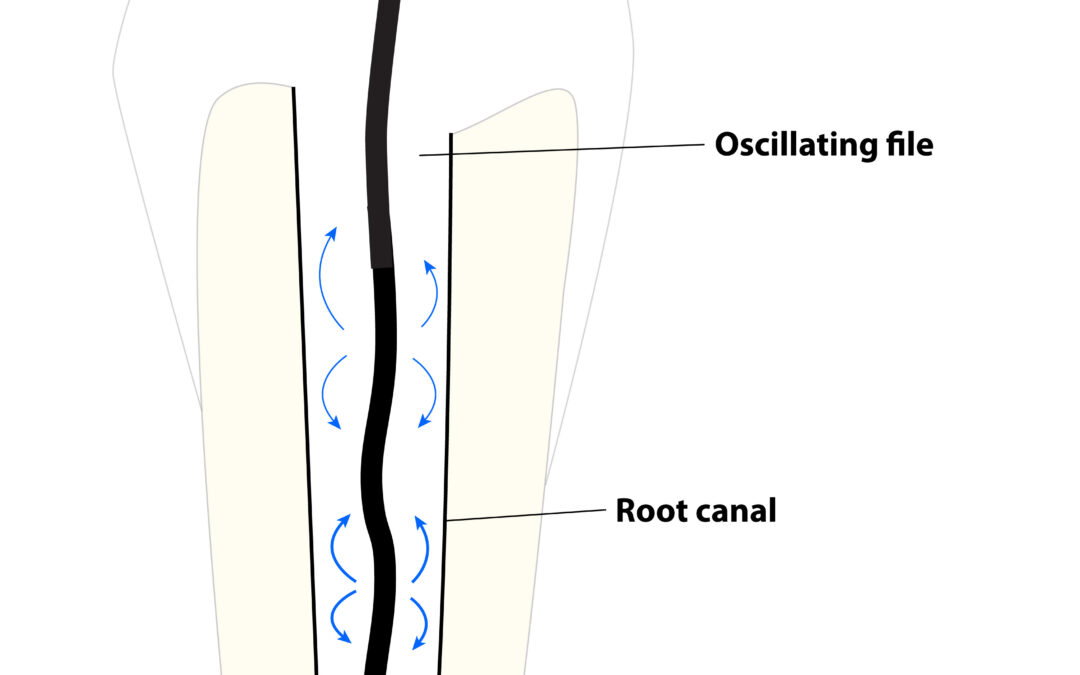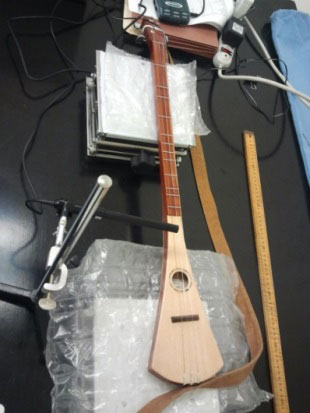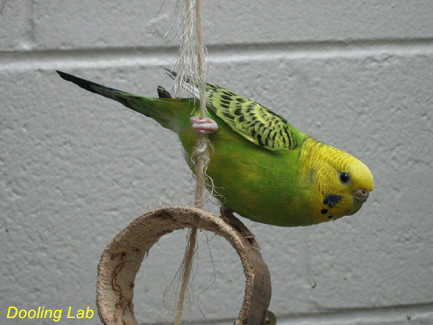
The exact cleaning mechanism, acoustic streaming, cavitation, a chemical effect, or a combination of these, is not yet known. In this study researchers attempt to reveal the cleaning mechanisms, using knowledge and expertise from physics, acoustics and dentistry.

Clay frog whistles can sound like natural frogs and possibly, their choruses were used in ceremonies Mayan ceremonies. Some scholars say that clay whistles were simple toys, but it was found that clay-frogs can sing like natural frogs and possibly, their choruses were used in ceremonies to the Mayan god of rain Chaac and other shamanic rites.
 Linda J. Hunt – ketteringhunt8831@gmail.comDepartment of PhysicsKettering UniversityFlint, MI, 48504, USA Daniel A. Russell – drussell@engr.psu.eduGraduate Program in AcousticsPennsylvania State UniversityUniversity Park, PA 16802, USA Popular version of...
Linda J. Hunt – ketteringhunt8831@gmail.comDepartment of PhysicsKettering UniversityFlint, MI, 48504, USA Daniel A. Russell – drussell@engr.psu.eduGraduate Program in AcousticsPennsylvania State UniversityUniversity Park, PA 16802, USA Popular version of...
 Robert J. Dooling – Dooling@psyc.umd.eduDepartment of Psychology,University of MarylandCollege Park, MD 20742 Otto GleichENT-Department, University of RegensburgFranz-Josef-Strauß-Allee 1193042 RegensburgGermany Geoffrey A. ManleyDepartment of Zoology,...
Robert J. Dooling – Dooling@psyc.umd.eduDepartment of Psychology,University of MarylandCollege Park, MD 20742 Otto GleichENT-Department, University of RegensburgFranz-Josef-Strauß-Allee 1193042 RegensburgGermany Geoffrey A. ManleyDepartment of Zoology,...

En este articulo describimos los resultatos obtenidos en el transporte de poli-1-lizinas de alto peso molecular a traves de la piel.
 Ludwig Weimann – info@ultra-sonictechnologies.comUltra-Sonic Technologies, LLC650 Industrial Park RdSt. Albans, VT 05478, USA Junru WuDepartment of Physics,University of Vermont,Burlington, VT 05405, USA Popular version of paper 4aBB2 presentedDecember 5, 2002...
Ludwig Weimann – info@ultra-sonictechnologies.comUltra-Sonic Technologies, LLC650 Industrial Park RdSt. Albans, VT 05478, USA Junru WuDepartment of Physics,University of Vermont,Burlington, VT 05405, USA Popular version of paper 4aBB2 presentedDecember 5, 2002...
 David Lubman, FASA – dlubman@ix.netcom.comAcoustical ConsultantWestminster, CA USA Popular version of paper 4pNSb4 presented December 1, 2006 at the 4th Joint ASA/ASJ Meeting in Honolulu, HI Back to lay language papers The Mesoamerican ballgame has been called...
David Lubman, FASA – dlubman@ix.netcom.comAcoustical ConsultantWestminster, CA USA Popular version of paper 4pNSb4 presented December 1, 2006 at the 4th Joint ASA/ASJ Meeting in Honolulu, HI Back to lay language papers The Mesoamerican ballgame has been called...
 Joshua J. Schwartz – jschwartz2@pace.eduDepartment of Biological SciencesPace UniversityPleasantville, NY 10570 Popular version of paper 2pAB10 presented at the First Pan-American/Iberian Meeting on Acoustics, Cancun, Mexico When animals are searching for a mate...
Joshua J. Schwartz – jschwartz2@pace.eduDepartment of Biological SciencesPace UniversityPleasantville, NY 10570 Popular version of paper 2pAB10 presented at the First Pan-American/Iberian Meeting on Acoustics, Cancun, Mexico When animals are searching for a mate...

We recorded chirps and trills from adult and juvenile Belding’s ground squirrels at multiple distinct locations in Yosemite National Park.

It is well known that ants do not respond to sound on a human scale. You can shout at an ant and it doesn’t seem to notice. Yet many ant species communicate by means of squeaking sounds from a stridulatory organ on the ant’s body, consisting of a washboard-like set of ridges and a scraper. The squeaking sounds are usually very faint but they pervade ant colonies. The amplified sound of a colony of black fire ants (Solenopsis richteri), disturbed by a microphone probe pushed into their mound, is given in the attached recording.

This paper reports new research indicating that a child’s perception of music may be influenced by the speech patterns of his or her mother. Previous findings by the author and colleagues had provided evidence that speech characteristics can have a strong influence on how we perceive music.

When the membrane is struck, many different modes or patterns of vibrations are excited, including the six important ones […]. Each of these modes of vibration has its own pattern of radiation.

One type of speech error currently under investigation is the malapropism. A malapropism is a whole word that supplants an intended word. (Other types of speech errors involve segments of sound supplanting intended sound segments). The words that are involved in malapropisms are related to each other in the way that they sound. However, the words that are involved in malapropisms are not related to each other in their meanings.

An understanding of the acoustical properties of straw bales is required if this medium is to be used appropriately. The transmission loss, a measure of how much sound energy is reduced in transmission through materials, was measured for a 20-inch-thick stuccoed wall of wheat and rye-grass straw bales. The effectiveness of straw bales to absorb sound was measured in an approximately cubical, ceramic-tiled room.

Acoustic Tim-Reversal-Mirrors (TRM) are, among many other applications, powerful instruments to detect defects in solid materials. Their ability to focus automatically on cracks makes them the most performant ultrasonic devices in this domain. In this paper, we prove that a simultaneous focalization of the different kinds of waves in the solid (transverse and longitudinal waves) can be obtained with such Time-Reversal-Mirrors.

One serious extinction pressure among many facing the tiger today is the ever advancing encroachment of humans into tiger territories. The sounds of industrialization that necessarily accompany encroachment almost certainly raise the fraction of anthropogenic noise being injected into the home ranges of tigers, diminishing their capacity to communicate vocally, and adding to the escalating threat to the big cats’ long-term odds for survival.

An analysis of 7-year long recordings of sea noise made at the CTBT underwater station off Cape Leeuwin in Western Australia has shown that Antarctica is the major source of low-frequency noise in the Southern Ocean and southern parts of the Indian Ocean. Two different kinds of signals arriving at the Cape Leeuwin station from Eastern Antarctica can generally be distinguished. The most amazing of them are iceberg songs, which are very-low-frequency, from about 3 Hz to 10 Hz multi-harmonic signals lasting sometimes for several hours and which are supposed to be produced by vibrations of the iceberg plate after collision with the seafloor, ice shelf or another iceberg.

When the Formosan subterranean termite (FST) (Coptotermes formosanus) and the native subterranean termite (RF) (Reticulitermes flavipes) detect a potential breach, the soldiers will usually bang their heads apparently to attract other soldiers for defense and to recruit additional workers to repair any breach.

Frogs and toads are among the most vocal of all animals. Generally speaking, male frogs call to attract females and to defend their calling sites or territories from other would-be suitors.

Our initial goal is to locate an open doorway or hallway through flames and smoke within a burning building, but even this simple goal could greatly enhance a firefighters ability to navigate through a burning building and out of danger. From a more fundamental physical acoustics perspective, we are interested in understanding how fire, heat and smoke between the device and a target effect acoustic propagation.
By analyzing the boron in ocean sediments scientists have been able to determine how acidic the ocean has been all the way back to 300 million years ago. We can then use this data to determine the low frequency sound transmission. It turns out that 300 million years ago the sound transmission in the ocean was quite similar to what we have today.

Students had to ensure the instruments played notes of the Western musical scale and that the timbres of the instruments allowed them to be played together in an ensemble. Finally, the students were required to compose original music for ensembles of these instruments and play them in a public concert in the college’s concert hall.

Studies show that musicians seldom use hearing protection despite being exposed to harmful sound levels on a daily basis. Noise-induced hearing loss does not distinguish between genres of music; as a consequence of overexposure to sound, famous artists such as Eric Clapton, Ozzy Osbourne, Pete Townshend, and Neil Young have reported suffering from hearing loss, tinnitus or both.

One important issue (and first step in our investigation) is the accurate estimation of fetal heart rate (FHR). An estimation of the FHR is obtained by evaluating the autocorrelation function of the Doppler signals for ill and healthy foetuses.

There is a critical need for organs and tissues for patients in need of organ transplantation or tissue reconstruction. The field of tissue engineering focuses on developing technologies that enable the replacement or repair of diseased or injured tissues and organs. Recent advances in this field include the engineering of skin substitutes, cartilage replacements, and artificial bladders, all of which are relatively thin tissues.

The 20th century was the noisiest century in the history of the world, resulting in the greatest loss of natural quiet in the history of the world. Noise spread into previously quiet lands, penetrating suburbs, rural areas, and even protected wilderness areas. Will the 21st century set a new record for noise, or begin a new era to bring back quiet?

A bray is a series of sounds produced by alternating inhaling (“Hees”) with exhaling (“Haws”).

Actor Gary Coleman, actress Natasha Richardson, and famed nutritionist Dr. Robert Atkins all passed away from complications due to traumatic brain injury (TBI). Unfortunately, these are not isolated cases; an estimated 1.7 million people sustain a TBI in the United States every year [1]. We have developed a novel ultrasound device that has the potential to change the narrative, and prevent future stories like these from ending in similar tragedy.

Our objectives for this project include an in depth analysis of the properties of stringed instruments. We strived to understand how different stringed instruments function individually, and how instruments differ in their sound and function. Stringed instruments create the sound in three phases: (i) the source or string, (ii) the medium or body and (iii) the interface, which is the oscillation of the air around the body. These elements interact to create the sound we hear in each instrument.

Who can think of the ocean without the cries of seagulls and the crashing of waves, or a summer night in the country without wind in the leaves and the chirping of insects? People have been recording soundscapes for decades, but recent advances in auralization (the creation of simulated acoustical spaces) have made computer simulated, but acoustically accurate, soundscapes possible.

The female lays her eggs in the sand or in a nest made with vegetation and guards them until juveniles hatch. At maturity when still inside their eggs, hatchlings emit calls and are responsive to their siblings’ vocalizations. This within-clutch communication synchronizes hatching. The mother also responds to these hatching calls […]

The “purring” wolf spider (Gladicosa gulosa) may be a unique exception to this assumption. Males create vibrations when they communicate with potential mates in a manner very similar to other wolf spider species, but unlike other wolf spider species, they also create airborne sounds during this communication.

Most earthquakes that rupture below the ocean shake the seafloor, generating sounds that can travel through the water for thousands of kilometers.
There are many different sounds that people perceive as unpleasant or that may cause physiological reactions, like chills down the spine. These sounds include scraping a plate with a fork, squeaking Styrofoam or scratching fingernails on a chalkboard. Sometimes simply imagining these sounds or actions may cause the corresponding perception or physiological reaction […]. The aim of our study was to detect specific features of the sounds responsible for the perceived unpleasantness.

North Atlantic right whales produce loud, broadband, short duration sounds referred to as gunshots. As the name depicts, these calls resemble the sound of a gun or rifle being fired.

Chimpanzees are well known for being loud, noisy animals. Film depictions of chimpanzees usually show them whimpering, hooting, screaming and generally making a ruckus. However, chimpanzees are also well known for being intelligent, and by using field experiments and naturalistic observations we have found new evidence that chimpanzees know when to keep quiet.

Hyenas are well known for their vocalizations, which eerily dominate the soundscape at night in the African savannah. The vocal repertoire of the spotted hyena is large, with more than ten different vocalizations. Since hyenas are predominantly nocturnal, vocal signalling is a privileged channel, used for both long- and short-range communications.

Many animals, from grasshoppers in a small field to baleen whales in the open ocean, use acoustic signals to find or attract conspecifics and potential mates, and the farther away you can make yourself heard, the better the odds are for finding mates and transmitting your genes into the next generation. Other animals, such as some primates, birds and meerkats, live in groups where most animals can forage while a few individuals keep watch for predators and raise the alarm in case of danger. Obviously, the distance that these calls are heard plays an important role in group organization and likely places an upper boundary on the dispersion of the group, decreasing foraging competition within the group if alarm calls travel farther and group is more dispersed.

New approaches suggest the possibility of artificially producing speech based on measuring facial movements with either attached facial probes or ultrasound. Such techniques could allow people to communicate through speech in places where it would otherwise be difficult or impossible.
Toothed whales (odontocetes), including sperm and beaked whales, emit very loud clicks into the water. They do this in order to echolocate: they listen to the echoes from the surface and the bottom to know where they are in the water column, and they listen to echoes from their prey in order to locate their food. A fascinating research question is whether whales can tell which of their comrades is clicking from subtle differences in the clicks emitted by each whale. There are evolutionary advantages to being able to identify the speaker.

Innovative, proactive regulation can successfully drive product development for lower noise emission levels to the benefit of the community and workers. In 2002, the New York City Department of Environmental Protection (DEP) undertook to completely revise the city’s Noise Code; the first major recrafting of the code in thirty years. The goal was to improve the quality of life for the people of New York City, but it is also having the collateral benefit of reducing occupational noise exposure for construction workers.

Birdsong has long served as a model for vocal development and communication. Zebra finches are a particularly interesting model because they sing just one song their entire lives, and they sing this song with little variation from rendition to rendition. Male zebra finches sing to other males to defend their territories and to females for mating displays. Thus, perception of song is important for species survival.

In the fall of 2009, a team of researchers from the Graduate Program in Acoustics at PSU made crowd noise measurements in Beaver Stadium (Americas largest college football stadium: cap. 107,282) in State College, PA, during PSU football games […]. The main goal was to map the crowd noise throughout the entire stadium to show the noisiest locations on the field, and, in turn, the sections of fans who were the loudest contributors.

If we cant see animals because of their naturally secretive behavior, how do we know they are really there and in what numbers so that we can make responsible conservation policy decisions about vulnerable habitats? This situation is exacerbated in Polar Regions where peculiar logistical difficulties of working in pack ice make survey effort enormously expensive, so a further challenge is to gather data cost-effectively. Acoustics, seeing animals with sound using an animals vocalizations as a proxy for field sightings, can be a simple, cost-effective tool. Some marine animals have stereotyped long-range signals which are ideal for cost-effective, repeatable surveying.

A survey was conducted to measure the sound levels from several different models of installed hand dryers. During the survey, the measurements were performed with and without hands in the airstream. This was found to be a significant factor to the loudness of the hand dryer. For some newer hand dryers models, high-speed airflows blowing onto the hands generates substantially higher noise levels.

Through observation, warble appears highly variable without obvious repetition of particular patterns of elements, indicating that there is no stereotyped song type being produced over and over again. On the other hand, certain combinations of warble elements are sung more often than others, suggesting that warble elements are not just randomly strung together either.

Free reed instruments were widespread in Southeast and East Asia for long before the “modern” Western free reed instruments, including the harmonica and the accordion-concertina “squeezebox” family, were developed in Europe starting about two hundred years ago. In the last 20 years there has been considerable interest in the acoustics of free reed instruments, including the Asian free reed mouth organs. This paper deals with two of the very simplest instruments of this type: the enggung of Bali, a single free reed without pipe-resonator, and the free reed buffalo horn, in which a single free reed is mounted in the side of the animal horn. It is hoped that study of these simple instruments will improve understanding of the acoustics of the free reed and the interaction of the reed with a resonator.

A baby Risso’s dolphin, a species found in warm temperate and tropical waters, was stranded on a beach in Southern Portugal and taken to the rehabilitation center at ‘Zoomarine’ oceanographic theme park in Portugal. Members of four other dolphin species had also stranded within two weeks and the baby seemed to be “listing,” or lying to one side. Elio Vicente, the director of the Rehabilitation Center at Zoomarine, called us and asked if it would be possible for us to come test the hearing of this infant dolphin.












































